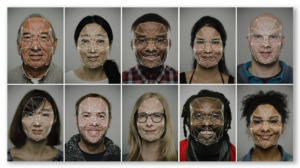
Feature topic: Facial recognition and ethical issues
Microsoft President Brad Smith gave a speech about the Microsoft facial recognition technology and ethical problems in the University of Sydney last month. He mentioned the current debate of privacy, accountability, racial discrimination and other ethical issues as well as the effort they are making to these problems. For the beginning of the feature, I will focus on the privacy issue when people are increasingly accustomed to the facial recognition technology. This technology not only brings us the convenience when scan our passport, work with the fingerprint identification, and help with detecting the suspicions, it also brings us questions: Are the citizens completely under the surveillance? Are these public facial recognition systems arthorized from governments or legal organizations? Where do our facial information and identification flow to? This feature will discuss these questions and compare the opinions of facial recognition technology from earlier years and recent years.
To help structure my feature, I will invite ResMed Chair in Biomedical Engineering Professor Philip De Chazal and Emeritus Professor of Law Emeritus Professor Terry Carney at the University of Sydney to explain ethical issues in the fields of law and public.
Publication and Target user
Facial recognition is a technology topic and it has the worldwide impact, so we choose an international science and technology publication – WIRED magazine.
WIRED is the technology magazine that collects the essential source of information and opinions of technology and life. It discusses how technology is changing life, business, art, ethics in our lives. The target users of WIRED magazine are male around age of 35, and most of them graduate from or at least college. They have median or high income to afford luxury items.
Sources and Media
- Multimedia: I will use the five-minute movie China: facial recognition and state control by The Economist in the first part of the feature to help readers understand the problems and cut my interviews into a 20 minutes movie for the interview part.
I will insert one feature image and three images (including two interviewees images), for example:


- Hypertext (I will add more than five hyperlinks in the feature), for example:
- facial recognition: It’s time for actionby Brad Smith (https://blogs.microsoft.com/on-the-issues/2018/12/06/facial-recognition-its-time-for-action/)
- Facial Recognitionby Techopedia (https://www.techopedia.com/definition/32071/facial-recognition)
News worthy
This topic is news worthy because it is controversial and full of human interest. People are increasingly focusing on the ethics. For instance, the attitude to facial recognition and big data is different between ten years ago and today. People pay attention to the importance of privacy and information protection, and it is reflected in the film and television productions, such as Black Mirror and BBC Radio Law in Action, Facial Recognition Technology. As we know, companies promise to respect the ethics. On the other hand, private information is the biggest commodity in today’s society so that companies, organizations and governments benefit from selling it. Overall, this feature will lead the trend of ethical discussion and deepen readers’ consideration of latest technology.



I think it is a great idea of feature story, with the development of frontier technology and the reasonable concerns about its application. It could arise readers’ awareness of facial recognition’s side effect, and remind us of the privacy invasion.
I would suggest some specific examples about the negative impacts of the facial recognition technology. Is there a case showing the potential danger of the technology? Has some one already been affected by the facial data collected by any organizations? These stories could support your views more strongly. Meanwhile, I believe some attention should be attached to the legal provision related to personal privacy. Maybe try to explain the current rules about the application of facial recognition, finding out the attitude of government to this technology.